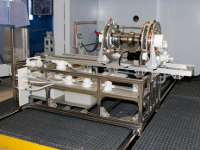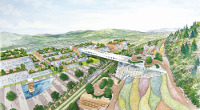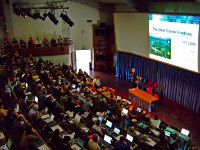From Fermilab Today: Introducing the ICPA: The right tool for the right job

Fermilab built this station for electropolishing SRF cavities. It is the fruit of an intense collaborative effort with Argonne National Laboratory, with input from Jefferson Lab, Oak Ridge National Laboratory and ABLE-EP, a local company. The station is one of several types of SRF surface treatment stations in the new Integrated Cavity Processing Apparatus. Image: Fermilab |
Developing and improving superconducting radio-frequency technology is an important goal for Fermilab. SRF technology allows us to conceive and plan for future accelerators, such as Project X, the ILC or the Muon Collider, or for energy production applications such as Accelerator Driven Systems. One thing that will help this goal is a new facility that we will start up next year in the Technical Division, named the Integrated Cavity Processing Apparatus.
Read more...
-- Giorgio Apollinari, head of Fermilab's Technical Division |
|
 |
The future city of the ILC

Architect's view of an international science research city. Image: K. Mori & K. Hayakawa |
What will happen when the ILC is built? One hopes discoveries will change the way we see the universe. It will answer the questions about what the universe is made of. And maybe it will help generate new Nobel Prize winners... “OK, I understand that something great will happen in the academic world. But I don't really get it,” some people might think. For these people, a symposium based on a recent study was held to explain what the city will be like if the ILC gets built at Mizusawa, Iwate prefecture, one of the two ILC candidate sites in Japan.
Read more...
-- Rika Takahashi |
 |
|
|
 |
What is it?

The festive season is around the corner and with it come recipes for turkey stuffing, misteltoe and fairy lights. This week's "What is it" is an array of rather festive lighting, too – can you identify what you see and what was used to see it? Then write to communicators@linearcollider.org! (Specialists not allowed!)
|
 |
|
|
 |
From The New Zealand Herald
22 November 2010
Cosmic cook up probes secrets of the universe
At the rate at which the Higgs is thought to occur, it should be found by 2014.Then, a new instrument - a linear electron positron collider - will be built to produce the particle in sufficient numbers to be able to study its properties.
Read more... |
|
From Physics
22 November 2010
Meet a superpartner at the LHC
Of the many ideas for new physics that can be tested at the Large Hadron Collider (LHC), supersymmetry is one of the most promising.
Read more... |
|
From Science Magazine
19 November 2010
New ITER Chief Aims to Get Some Financial Wiggle Room
"My responsibility as director-general is to complete construction within the [now] capped cost," Motojima told Science after the meeting. "Cost saving is very important."
Read more... |
|
From CERN
17 November 2010
Antimatter atoms produced and trapped at CERN
In a paper published in Nature today, the [ALPHA] collaboration shows that it has successfully produced and trapped atoms of antihydrogen.
Read more... |
|
|
 |
 |
|
|
 |
The ILC-CLIC collaboration and technological challenges
Today's issue features a Director's Corner from Kaoru Yokoya, Global Design Effort Asian Regional Director.

CERN's DG Rolf Heuer presenting the Linear Collider roadmap during the ILC-CLIC meeting at CERN in November 2010. Image: Nobu Toge |
In recent years, the collaboration between the ILC and CLIC communities has developed and evolved, and Barry Barish has reported on this collaboration in previous corners. Working groups on many R&D areas have been formed. Recently the Accelerator General Issues Group, which takes care of project strategy and planning, and the Detector Group have also formed. Last month in Geneva, we held our first ILC-CLIC joint meeting (IWLC10), as Peter Garbincius reported. ILC and CLIC are quite different in their ultimate target energies and in their fundamental acceleration mechanisms. Nonetheless, as electron-positron linear colliders they have many technological common areas. Under the tough situation of limited resources around the world, this collaboration is welcome and, actually, we have been producing good results.
Read more...
-- Kaoru Yokoya
Director's Corner Archive |
 |
|
|
 |
Early edition of ILC NewsLine this week
Because of the Thanksgiving holiday in the United States this Thursday, we are publishing an early edition of ILC NewsLine this week. The publication will return to its normal schedule next week.
ILC Notes
2010-057
ILC Damping Ring Design Studies at the Cockcroft Institute
2010-056
DCO4 lattice design for 6.4 km ILC damping rings
ILC-HiGrade Reports
2010-001
Tuner Status
2010-002
Coupler Status
2010-004
Siting Study
2010-005
Cavity Process
2010-006
Transport Simulation on XFEL cavity design
|
|

